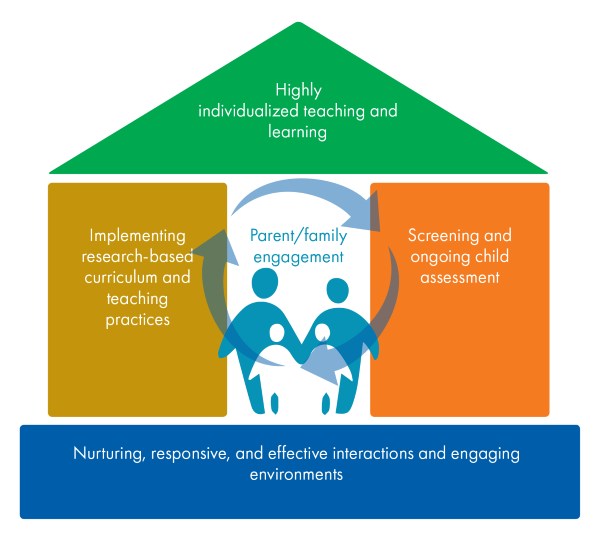
The National Center on Early Childhood Development, Teaching, and Learning uses a house to represent five integral elements of quality teaching and learning for children ages birth to 5 in all program options.
The five elements of the House Framework include:
- Foundation: Providing nurturing, responsive, and effective interactions and engaging environments
- First Pillar: Implementing research-based curriculum and teaching and home visiting practices
- Second Pillar: Using screening and ongoing assessment of children's skills
- Roof: Embedding highly individualized teaching and learning
- Center: Engaging parents and families
When these elements are connected, they form a single structure that surrounds the family in the center. The family is at the heart of the house because programs implement each element in partnership with parents and families in their cultural and community context.
Explore this resource to learn how you can use the House Framework to foster children’s development and learning.
Supporting School Readiness for All Children
Foundation: Nurturing, Responsive, and Effective Interactions and Engaging Environments
Nurturing, responsive, and effective interactions and engaging environments are the foundation for all learning in early childhood settings. Children and families benefit from interactions and environments that are culturally and linguistically responsive.
High-quality early learning group settings include:
- A well-organized and managed learning environment
- Social and emotional support
- Intentional teaching practices, interactions, and materials that stimulate children's thinking, development, and skills
Home visitors also assist parents in using their home and community as a learning environment.
The First Pillar: Implementing Research-based Curriculum and Teaching Practices
Developmentally appropriate research-based early childhood curricula for group care settings, including curriculum enhancements and curricula that have been significantly adapted to meet the needs of specific populations, provide:
- Content-rich learning experiences that support children’s growth in key areas of development that are aligned with the Head Start Early Learning Outcomes Framework (ELOF)
- Content through an organized developmental scope and sequence that includes plans and materials for learning experiences based on developmental progressions and how children learn
Home-based curricula also provide content-rich experiences aligned with the ELOF and an organized developmental scope and sequence. Importantly, home-based curricula promote the parents’ role as the child’s first teacher through experiences that focus on the parent–child relationship.
Whether group care or home-based, curricula and related teaching practices are linguistically and culturally responsive to children and families. Children, parents, and families benefit from a high-quality, research-based curriculum when it is implemented with fidelity.
The Second Pillar: Screening and Ongoing Child Assessment
Screening and ongoing assessment are integral to supporting children’s development and learning, especially when they are conducted in ways that are responsive to children's home languages and cultures.
Developmental screening is an initial check to identify children who may need further evaluation to determine if they have a delay or disability. Screenings typically look at developmental, behavioral, motor, language, cognitive, social, and emotional skills.
Ongoing assessment provides information about children’s developmental levels and progress toward individual child goals, as well as program school readiness goals. Programs align their school readiness goals with the ELOF.
- Ongoing assessment information, along with input from parents and families, helps staff determine a child’s strengths and needs. Staff and families then adjust strategies to better support individualized learning and curriculum implementation
- Ongoing assessment information also helps improve teaching practices in center-based and family child care settings, as well as home visit strategies in home-based programs
- Head Start programs ensure child assessment tools align with the ELOF
The Roof: Highly Individualized Teaching and Learning
All children benefit from individualized learning opportunities that are linguistically and culturally responsive. However, some children may require more specialized support to access and participate in learning and social experiences and activities. This includes children with identified disabilities, as well as children who are at risk for developmental delays. Specialized supports may include:
- Specific teaching practices and ways of interacting with children
- Adaptations to daily schedules and the learning environment
- Use of assistive technology
- Other strategies that meet individual children’s needs
The Center: Parent and Family Engagement
Quality teaching practices recognize parents and families as children’s lifelong educators and experts on what is best for their children’s and family’s well-being. Engaging parents and families in every aspect of the practices depicted in the House Framework means:
- Communicating effectively with parents and families
- Forming positive, goal-directed relationships with parents and families
- Including parents and families in decisions and teaching practices for their child’s learning, like:
- Screening and assessing children
- Planning for interactions and learning environments
- Implementing curriculum
- Promoting home–school consistency by working with parents and families to reinforce children’s learning everywhere that children learn
- Ensuring these practices are culturally and linguistically responsive and meet individual needs
Read more:
Resource Type: Article
National Centers: Early Childhood Development, Teaching and Learning
Last Updated: May 16, 2025